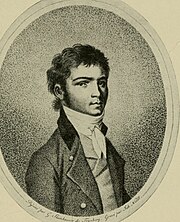The String Quartet No. 1 in F major, Op. 18, No. 1, was written by Ludwig van Beethoven between 1798 and 1800, published in 1801. The complete set of six quartets was commissioned by and dedicated to the Bohemian aristocrat Joseph Franz von Lobkowitz. It is actually the second string quartet that Beethoven composed, following his third.
| String Quartet | |
|---|---|
| No. 1 | |
| Early string quartet by Ludwig van Beethoven | |
 Ludwig van Beethoven, c.1796 | |
| Key | F major |
| Opus | 18, No. 1 |
| Composed | 1798–1800 |
| Dedication | Joseph Franz von Lobkowitz |
| Published | 1801 |
| Movements | Four |
Structure
editThe quartet consists of four movements:
- Allegro con brio (F major)
- Adagio affettuoso ed appassionato (D minor)
- Scherzo: Allegro molto (F major)
- Allegro (F major)
The theme of the finale is almost directly borrowed from the finale of his earlier string trio, Op. 9, No. 3 in C minor; the themes are very closely related. The principal theme of the first movement echoes that of Mozart's Violin Sonata No. 32 K. 454 (1784) and Haydn's 1787 Opus 50, No. 1 quartet.[1]
History
editAccording to Carl Amenda, Beethoven's friend, the second movement was inspired by the crypt scene[2] from William Shakespeare's Romeo and Juliet. The quartet was heavily revised between the version that Amenda first received, and that was dedicated to him, and the one that was sent to the publisher a year later, including changing the second movement's marking from Adagio molto to the more specific Adagio affettuoso ed appassionato. Of these modifications, Beethoven wrote: "Be sure not to hand on to anybody your quartet, in which I have made some drastic alterations. For only now have I learnt to write quartets; and this you will notice, I fancy, when you receive them."[3]
The "Amenda" manuscript, as it is sometimes known, was edited by Paul Mies and published by Bärenreiter around 1965, and by G. Henle Verlag of Munich (perhaps also edited by Mies) in 1962.[4] This early version of one of Beethoven's best-known works has been recorded perhaps fewer than a half-dozen times as of July 2014.[5]
In popular culture
editThe second movement of the Juilliard String Quartet's recording is used in the soundtrack to the 2015 film The Lobster.[6]
Notes
edit- ^ Sutcliffe 1992, p. 67.
- ^ Romeo and Juliet 5.3, Folger Shakespeare Library
- ^ Winter & Martin 1994, p. 151.
- ^ See OCLC 803615623, OCLC 59009141.
- ^ The first movement by the Juilliard String Quartet in 2008 OCLC 319178284, but before that, the premiere was given by the Pro Arte Quartet on a Laurel Records cassette/long-playing record in 1981 OCLC 612773288 (with notes by musicologist Lewis Lockwood.) ("Original version" in the title of that record should perhaps be recast as earliest "surviving" version.) There is another complete recording – listed as Hess 32 – here: OCLC 156914724, played by the Quartetto Paolo Borciani, released 2007; also by the Hagen Quartet on a Deutsche Grammophon set (OCLC 38129193).
- ^ "The Lobster Soundtrack Announced". Film Music Reporter. 9 May 2016. Retrieved 13 August 2024.
Sources
edit- Sutcliffe, W. Dean (1992). Haydn: String Quartets, Op. 50. Cambridge: Cambridge University Press. ISBN 0521399955.
- Winter, Robert; Martin, Robert, eds. (1994). The Beethoven Quartet Companion. University of California Press. ISBN 0-520-08211-7. (Especially the essay by Michael Steinberg, pp. 150–155.)
Further reading
edit- Vernon, David (5 September 2023). Beethoven: The String Quartets. Edinburgh: Candle Row Press. ISBN 978-1739659929.
- Whiting, Stephen M. (Fall 2018). "Beethoven Translating Shakespeare: Dramatic Models for the Slow Movement of the String Quartet Op. 18, No. 1". Journal of the American Musicological Society, vol. 71, no. 3, pp. 795–838.
External links
edit- String Quartet No. 1 in F major, Op. 18: Scores at the International Music Score Library Project
- "Programme notes on the Beethoven string quartets" by British broadcaster and composer Robert Simpson
- Animated score on YouTube, Emerson String Quartet (Eugene Drucker, violin; Philip Setzer, violin; Lawrence Dutton, viola; Paul Watkins, cello)